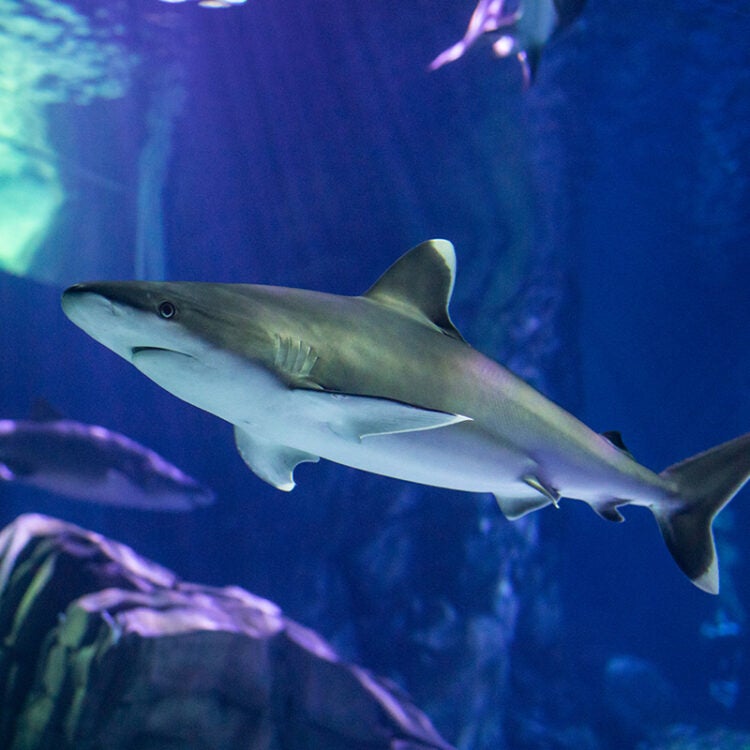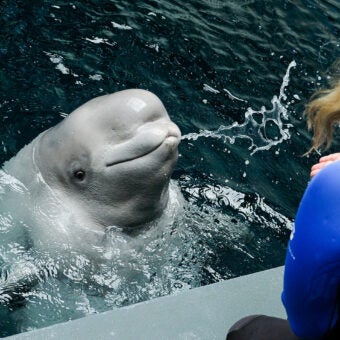-
Size
6-8 feet (2-2.4 m) -
Diet
Fish, small sharks and rays, cephalopods, octopuses, squids and crustaceans -
Range
Western Indian Ocean -
Habitat
Offshore islands, coral banks and reefs
Physical Characteristics
- The body is long and slender with a broad, rounded snout and distinct large eyes.
- 12-14 strong, serrated teeth in both the lower and upper jaw.
- Large pectoral fins that are narrowly rounded or pointed at the tips.
- Coloration varies between a dark gray, brown-gray or blue-gray dorsal surface with a bronzy sheen that fades into a white ventral surface.
- The most distinguishing feature is the white tips and borders on all fins.
- Closely resembles the grey reef shark and the whitetip reef shark. These species differ slightly in coloration; the grey reef shark has dark tips on its pectoral fins and the whitetip reef shark only has the white tip on the dorsal fin, not the pectoral fins.
- Common length between 6-8 feet (2-2.4 m).
- The maximum recorded length is 9.8 feet (2.9 m).
- The maximum recorded weight is 357.6 pounds (162.2 kg).
- Females tends to be larger than males.
Diet / Feeding
- Diet consists of bony fish, rays, cephalopods, small sharks, octopuses, squids, and crustaceans.
- The silvertip shark is an apex predator, meaning it is at the top of the food chain and has very few natural predators of its own.
- Has been observed swimming among other feeding sharks and darting into the group to swipe food.
- Pups feed on small fish.
- Voracious feeders.
Range / Habitat
- Occurs inshore over or adjacent to continental and insular shelves.
- Commonly found around offshore islands, coral banks, and reefs.
- Lives at a depth range of 3-2,625 feet (1-800 m).
- Juvenile typically remains close to shore and in shallow water to minimize predation risk.
- Found primarily in the western Indian Ocean.
- Including the Red Sea and eastern African waters surrounding Madagascar, Seychelles, Aldabra Group, Mauritius, and the Chagos Archipelago.
- Occupies the western Pacific Ocean from southern Japan, northern Australia, and eastern-central Pacific areas ranging from southern Baja, California, and Mexico, to Colombia including Cocos, Galapagos, and Revillagigedo Islands.
Reproduction & Growth
- Viviparous; the embryos develop within the mother’s uterus and are nourished by the yolk sac placenta; females give birth to live young.
- The average gestation period is 12 months.
- May give birth to up to 11 pups per litter; the average litter has 5-6 pups.
- When born, pups are typically 1.6-2.6 feet (0.5-0.8 m).
- Pups live among shallow reefs and move out into deeper water as their size increases.
- Mates once a year in the summer months.
- No parental involvement from males beyond fertilization and no parental involvement from females following birth.
- Breeding and pupping both occur during the summer months in the Southern Hemisphere.
- Males reach sexual maturity around 5.2-5.9 feet (1.6-1.8 m).
- Females reach sexual maturity around 5.2-6.2 feet (1.6-1.9 m).
Conservation Status
- Listed as “Vulnerable” on The IUCN Red List.
Sources
www.fishbase.org
www.iucnredlist.org
www.flmnh.ufl.edu/fish
www.animaldiversity.org







